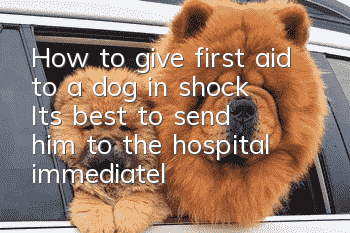How to give first aid to a dog in shock? It’s best to send him to the hospital immediately.

Treatment of cardiogenic shock in dogs
1. Let the dog lie still, control the infection, and use physical cooling methods to cool the dog.2. For pain relief, morphine hydrochloride can be used.
3. For those who vomit, apply atropine sulfate.
4. Correct acid-base balance imbalance, paying special attention to correcting metabolic acidosis.
5. For oxygen infusion and fluid replenishment, intravenous infusion of isotonic sugar saline and 10% low molecular weight dextran can be used.
6. Use adrenomimetic drugs and intravenous infusion at a dilution of 1:250 to maintain the heart rate at 80-140 beats/minute.
Treatment of toxic shock in dogs
1. Remove toxic substances and use antibiotics to kill germs. When antibiotics are used, two or more types are usually used in combination.2. Replenish effective circulating blood volume: Use physiological saline and Ringer's solution to replenish it in time.
3. Use vasoactive drugs to prevent microcirculatory stasis.
4. Correct acidosis.
5. Enhance myocardial contractility.
6. To deal with complications, such as difficulty breathing, provide oxygen in time, or perform tracheal intubation to provide oxygen.
Treatment of anaphylactic shock in dogs
1. Immediately stop using or remove the substances that cause allergic reactions.2. Make the dog lie on its back and keep warm.
3. Immediately intravenously inject 0.5-1.0 ml of 1:1000 adrenaline hydrochloride. If the heartbeat suddenly stops, intracardiac injection of 1 ml of epinephrine 1:1000 is performed every week and chest compressions are performed. If the first injection of adrenal cord is ineffective, the injection can be repeated once.
4. Keep breathing smooth and provide oxygen. If necessary, intubate the trachea for artificial respiration.
5. Intravenous injection of hormone drugs.
6. Apply anti-allergic drugs.
7. Replenish blood volume.
8. Streptomycin allergy: Add 10 to 20 ml of 10% calcium gluconate, inject slowly intravenously, and give it again half an hour later.
Treatment of hemorrhagic shock in dogs
1. Hemostasis: Regardless of surface or internal bleeding, hemostatic drugs can be used, such as Anluoxue, Agrimony, Notoginseng, Baiyao, etc. However, the hemostatic effect of the drug is uncertain and can only play an auxiliary role.2. Replenish blood volume.
3. Blood transfusion: For patients with severe blood loss, blood transfusion should be the main method, supplemented by other liquids. The volume and speed of blood transfusion should be adjusted according to changes in clinical manifestations.
Treatment of traumatic shock in dogs
1. Give analgesics.2. Deal with the dog’s trauma in a timely manner: stop bleeding, fixate (if there is a fracture, fix it in time), debridement (clean the wound to prevent infection), and bandage.
3. Prevent and correct acidosis: 30-100 ml of 5% sodium bicarbonate, intravenous injection.
4. Rehydration: Dextran can be used, and infusion treatment should be carried out according to the first aid measures for hemorrhagic shock.
5. Blood transfusion: According to the dog’s blood loss, refer to the blood transfusion measures for hemorrhagic shock.
6. If blood and plasma cannot be transfused immediately, or the blood volume has been basically replenished but the blood pressure still cannot be maintained normal, vasoconstrictors such as isoproterenol can be considered.
7. Give a large amount of antibiotics in the early stage. You can choose cephalosporin, ampicillin, etc. after dilution and intravenous drip.
8. If surgery is needed, surgery should be performed on the dog as soon as possible.
If a dog is in shock, it should be sent to the hospital immediately for professional treatment. Do not delay the treatment opportunity.
Random articles
- What do dogs eat to protect their stomach? It is important to protect their stomach and treat gastrointestinal diseases in dogs.
- How to tell if your dog is fat? Is your dog overweight?
- Will your dog catch a cold if you blow the air conditioner? What should you do if your dog catches a cold if you blow the air conditioner?
- What should you pay attention to when your dog drinks water? Don’t be careless when it comes to your dog’s drinking water.
- The dog's mouth bites and shakes. Why does the dog's mouth occasionally shake and bite?
- How to cut a dog's hair? Do you know how to cut a dog's hair correctly?
- Can dogs eat raw eggs? Why can’t dogs eat egg whites?
- Common Dog Problems in Summer How to Deal with Different Dog Problems
- How to keep dogs away from skin diseases. If you do this, will you see if your dog will still be infected with skin diseases?
- What causes anorexia in dogs? Dogs will become anorexic due to lack of exercise. Hounds run at least 5KM every day.



